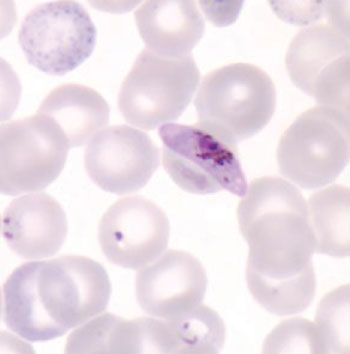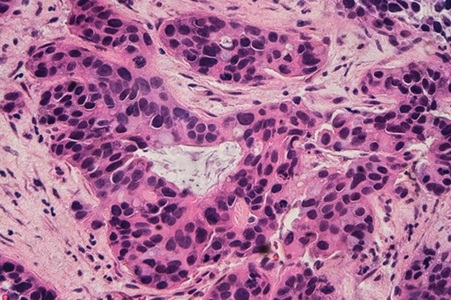Highly Sensitive Method Detects Malaria Parasites
|
By LabMedica International staff writers Posted on 18 Mar 2015 |

Image: A gametocyte of Plasmodium falciparum in a thin blood smear and also seen are ring-form trophozoites and a red blood cell exhibiting basophilic stippling (Photo courtesy of Dr. Mae Melvin).
A large proportion of asymptomatic malaria infections can only be identified by surveillance with molecular methods, yet these infections also contribute to onward transmission to mosquitoes.
New molecular assays that take advantage of genes with multiple copies in the parasite genome have been developed that can detect malaria parasites in human blood at very low levels and might be helpful in the campaign to eradicate malaria.
An international team of scientists led by those at the Swiss Tropical and Public Health Institute (Basel, Switzerland) compared three methods to detect malaria parasites in 498 samples randomly selected from a malaria survey in Tanzania: light microscopy, the current standard molecular assay, and the new assays. Two quantitative polymerase chain reaction (qPCR) assays were developed for ultra-sensitive detection of Plasmodium falciparum, targeting the high-copy telomere-associated repetitive element 2 (TARE-2, ~250 copies/genome) and the var gene acidic terminal sequence (varATS, 59 copies/genome).
Parasites were detected in 25% of samples by light microscopy, in 50% by the standard assay, and in 58% by the new assays. Compared to the new assays, the current molecular standard assay failed to identify 16% of infections, and at least 40% of those contained parasite gametocytes, the parasite stage that is transmitted when mosquitoes bite an infected person. Standard PCR is widely considered a molecular gold standard of malaria diagnosis complementing light microscopy, the traditional gold standard, yet these results suggest that this notion requires revision.
The new assays detect only the most common malaria parasite, P. falciparum, and while they can use very small blood samples collected in the field, the analysis itself needs to be done in a biomedical laboratory. Nonetheless, because low-density infections without disease symptoms are expected to become increasingly common as countries improve malaria control, ultra-sensitive tools such as these will likely be critical for malaria surveillance and for monitoring the progress of malaria control and elimination programs. The study was published on March 3, 2015, in the journal Public Library of Science Medicine.
Related Links:
Swiss Tropical and Public Health Institute
New molecular assays that take advantage of genes with multiple copies in the parasite genome have been developed that can detect malaria parasites in human blood at very low levels and might be helpful in the campaign to eradicate malaria.
An international team of scientists led by those at the Swiss Tropical and Public Health Institute (Basel, Switzerland) compared three methods to detect malaria parasites in 498 samples randomly selected from a malaria survey in Tanzania: light microscopy, the current standard molecular assay, and the new assays. Two quantitative polymerase chain reaction (qPCR) assays were developed for ultra-sensitive detection of Plasmodium falciparum, targeting the high-copy telomere-associated repetitive element 2 (TARE-2, ~250 copies/genome) and the var gene acidic terminal sequence (varATS, 59 copies/genome).
Parasites were detected in 25% of samples by light microscopy, in 50% by the standard assay, and in 58% by the new assays. Compared to the new assays, the current molecular standard assay failed to identify 16% of infections, and at least 40% of those contained parasite gametocytes, the parasite stage that is transmitted when mosquitoes bite an infected person. Standard PCR is widely considered a molecular gold standard of malaria diagnosis complementing light microscopy, the traditional gold standard, yet these results suggest that this notion requires revision.
The new assays detect only the most common malaria parasite, P. falciparum, and while they can use very small blood samples collected in the field, the analysis itself needs to be done in a biomedical laboratory. Nonetheless, because low-density infections without disease symptoms are expected to become increasingly common as countries improve malaria control, ultra-sensitive tools such as these will likely be critical for malaria surveillance and for monitoring the progress of malaria control and elimination programs. The study was published on March 3, 2015, in the journal Public Library of Science Medicine.
Related Links:
Swiss Tropical and Public Health Institute
Latest Microbiology News
- Rapid Assay Identifies Bloodstream Infection Pathogens Directly from Patient Samples
- Blood-Based Molecular Signatures to Enable Rapid EPTB Diagnosis
- 15-Minute Blood Test Diagnoses Life-Threatening Infections in Children
- High-Throughput Enteric Panels Detect Multiple GI Bacterial Infections from Single Stool Swab Sample
- Fast Noninvasive Bedside Test Uses Sugar Fingerprint to Detect Fungal Infections
- Rapid Sepsis Diagnostic Device to Enable Personalized Critical Care for ICU Patients
- Microfluidic Platform Assesses Neutrophil Function in Sepsis Patients
- New Diagnostic Method Confirms Sepsis Infections Earlier
- New Markers Could Predict Risk of Severe Chlamydia Infection
- Portable Spectroscopy Rapidly and Noninvasively Detects Bacterial Species in Vaginal Fluid
- CRISPR-Based Saliva Test Detects Tuberculosis Directly from Sputum
- Urine-Based Assay Diagnoses Common Lung Infection in Immunocompromised People
- Saliva Test Detects Implant-Related Microbial Risks
- New Platform Leverages AI and Quantum Computing to Predict Salmonella Antimicrobial Resistance
- Early Detection of Gut Microbiota Metabolite Linked to Atherosclerosis Could Revolutionize Diagnosis
- Viral Load Tests Can Help Predict Mpox Severity
Channels
Clinical Chemistry
view channel
Chemical Imaging Probe Could Track and Treat Prostate Cancer
Prostate cancer remains a leading cause of illness and death among men, with many patients eventually developing resistance to standard hormone-blocking therapies. These drugs often lose effectiveness... Read more
Mismatch Between Two Common Kidney Function Tests Indicates Serious Health Problems
Creatinine has long been the standard for measuring kidney filtration, while cystatin C — a protein produced by all human cells — has been recommended as a complementary marker because it is influenced... Read moreMolecular Diagnostics
view channel
Portable Molecular Test Detects STIs at POC in 15 Minutes
Sexually transmitted infections (STIs) such as Chlamydia trachomatis and Neisseria gonorrhoeae affect more than 370 million people annually, with women in low- and middle-income countries facing the greatest... Read more
Benchtop Analyzer Runs Chemistries, Immunoassays and Hematology in Single Device
Routine blood tests remain dependent on off-site laboratories, resulting in delays, higher costs, and logistical barriers in decentralized care settings. Now, a new multimodal diagnostic solution delivers... Read moreHematology
view channel
Platelet Activity Blood Test in Middle Age Could Identify Early Alzheimer’s Risk
Early detection of Alzheimer’s disease remains one of the biggest unmet needs in neurology, particularly because the biological changes underlying the disorder begin decades before memory symptoms appear.... Read more
Microvesicles Measurement Could Detect Vascular Injury in Sickle Cell Disease Patients
Assessing disease severity in sickle cell disease (SCD) remains challenging, especially when trying to predict hemolysis, vascular injury, and risk of complications such as vaso-occlusive crises.... Read more
ADLM’s New Coagulation Testing Guidance to Improve Care for Patients on Blood Thinners
Direct oral anticoagulants (DOACs) are one of the most common types of blood thinners. Patients take them to prevent a host of complications that could arise from blood clotting, including stroke, deep... Read moreImmunology
view channel
Gene Signature Test Predicts Response to Key Breast Cancer Treatment
DK4/6 inhibitors paired with hormone therapy have become a cornerstone treatment for advanced HR+/HER2– breast cancer, slowing tumor growth by blocking key proteins that drive cell division.... Read more
Chip Captures Cancer Cells from Blood to Help Select Right Breast Cancer Treatment
Ductal carcinoma in situ (DCIS) accounts for about a quarter of all breast cancer cases and generally carries a good prognosis. This non-invasive form of the disease may or may not become life-threatening.... Read morePathology
view channel
Diagnostic Technology Performs Rapid Biofluid Analysis Using Single Droplet
Diagnosing disease typically requires milliliters of blood drawn at clinics, depending on needles, laboratory infrastructure, and trained personnel. This process is often painful, resource-intensive, and... Read more
Novel Technology Tracks Hidden Cancer Cells Faster
Targeting and treating disease often hinges on the ability to locate specific cells inside the body—a challenge made difficult because harmful or therapeutic cells move through tissues and are not easily detected.... Read moreTechnology
view channel
AI Saliva Sensor Enables Early Detection of Head and Neck Cancer
Early detection of head and neck cancer remains difficult because the disease produces few or no symptoms in its earliest stages, and lesions often lie deep within the head or neck, where biopsy or endoscopy... Read more
AI-Powered Biosensor Technology to Enable Breath Test for Lung Cancer Detection
Detecting lung cancer early remains one of the biggest challenges in oncology, largely because current tools are invasive, expensive, or unable to identify the disease in its earliest phases.... Read moreIndustry
view channel
Abbott Acquires Cancer-Screening Company Exact Sciences
Abbott (Abbott Park, IL, USA) has entered into a definitive agreement to acquire Exact Sciences (Madison, WI, USA), enabling it to enter and lead in fast-growing cancer diagnostics segments.... Read more




 assay.jpg)



















